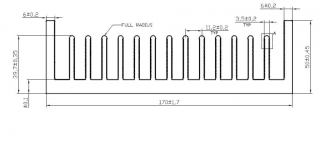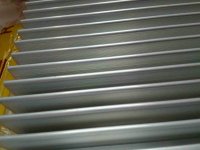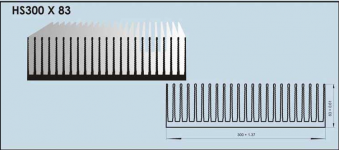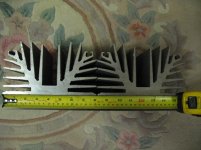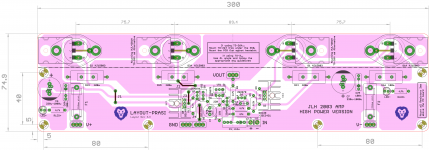I have a question of my own,
I have four of the attached heatsinks with a depth of 165mm. can 2 of these per channel for this amp be suitable? I plan to use a spreader plate of 10mm thickness in a 5U case on which the heatsinks will mount from the outside and o/p devices (on a L/T bracket ) from the inside.
if not acceptable from dissipation point of view, upto what power level can these heatsinks be suitable (guesstimate is what i a looking for). unfortunately no thermal res data is available for the heatsinks.
Further more, if this cant be answered, upto what sink temperature is acceptable? 50-55 degree C.?
the sinks do have tiny serrations on fins, so they may help it with dissipation.
last option would be to use fan, although undesirable , as i cant afford to invest in heatsinks, they cost too much..
, as i cant afford to invest in heatsinks, they cost too much..
If none of this, then buy new heaksinks HS 300mm x 83mm x 200mm?
I have four of the attached heatsinks with a depth of 165mm. can 2 of these per channel for this amp be suitable? I plan to use a spreader plate of 10mm thickness in a 5U case on which the heatsinks will mount from the outside and o/p devices (on a L/T bracket ) from the inside.
if not acceptable from dissipation point of view, upto what power level can these heatsinks be suitable (guesstimate is what i a looking for). unfortunately no thermal res data is available for the heatsinks.
Further more, if this cant be answered, upto what sink temperature is acceptable? 50-55 degree C.?
the sinks do have tiny serrations on fins, so they may help it with dissipation.
last option would be to use fan, although undesirable
 , as i cant afford to invest in heatsinks, they cost too much..
, as i cant afford to invest in heatsinks, they cost too much..If none of this, then buy new heaksinks HS 300mm x 83mm x 200mm?
Attachments
Last edited:
I have a question of my own,
I have four of the attached heatsinks with a depth of 165mm. can 2 of these per channel for this amp be suitable? I plan to use a spreader plate of 10mm thickness in a 5U case on which the heatsinks will mount from the outside and o/p devices (on a L/T bracket ) from the inside.
if not acceptable from dissipation point of view, upto what power level can these heatsinks be suitable (guesstimate is what i a looking for). unfortunately no thermal res data is available for the heatsinks.
Further more, if this cant be answered, upto what sink temperature is acceptable? 50-55 degree C.?
the sinks do have tiny serrations on fins, so they may help it with dissipation.
last option would be to use fan, although undesirable, as i cant afford to invest in heatsinks, they cost too much..

Who ever calculate these will need rail voltage, also if you plan to use regulated PS or simple CRC capacitor bank. If you look at the original high power JLH the guy use an extra pair heatsink just for the regulators per mono block.
It look like your heatsink decent size, I hope someone will post his or her experience.
JLH Class-A Amplifier
Last edited:
I would guess that the 170 long heatsink has an Rth s-a of ~0.5 to 0.6C/WI have a question of my own,
I have four of the attached heatsinks with a depth of 165mm. can 2 of these per channel for this amp be suitable? I plan to use a spreader plate of 10mm thickness in a 5U case on which the heatsinks will mount from the outside and o/p devices (on a L/T bracket ) from the inside.
if not acceptable from dissipation point of view, upto what power level can these heatsinks be suitable (guesstimate is what i a looking for). unfortunately no thermal res data is available for the heatsinks.
Further more, if this cant be answered, upto what sink temperature is acceptable? 50-55 degree C.?
the sinks do have tiny serrations on fins, so they may help it with dissipation.
last option would be to use fan, although undesirable, as i cant afford to invest in heatsinks, they cost too much..
If none of this, then buy new heaksinks HS 300mm x 83mm x 200mm?
Two fitted to one channel will give you ~0.25 to 0.3C/W if NOT fitted one above the other.
I would guess that the 170 long heatsink has an Rth s-a of ~0.5 to 0.6C/W
Two fitted to one channel will give you ~0.25 to 0.3C/W if NOT fitted one above the other.
Thanks for helping!. I will be using them side-by-side. I think the arrangement should be sufficient for the build + to cheer, is the spreader plate of ~400mm long x ~225mm wide x 10mm thick, that should do its own bit. of course, I shall monitor the h/s temperature and implement other remedies. So max temp of h/s less than 50-55 deg. C is the goal here.
regards
Prasi
Thanks for helping!. I will be using them side-by-side. I think the arrangement should be sufficient for the build + to cheer, is the spreader plate of ~400mm long x ~225mm wide x 10mm thick, that should do its own bit. of course, I shall monitor the h/s temperature and implement other remedies. So max temp of h/s less than 50-55 deg. C is the goal here.
regards
Prasi
I buy a cerwin vega (A400,A1600/1800)amplifier broken for spares because they have 4U chassis and they are original equiped with transistors TO3 and big heatsink
I buy a cerwin vega (A400,A1600/1800)amplifier broken for spares because they have 4U chassis and they are original equiped with transistors TO3 and big heatsink
the last option would be to go for these (attached), of 200 mm depth. For me!.
reg
Prasi
Attachments
I have the design finalized, will post tomorrow. boy, it takes too much time to adjust here and there... is rail indication led recommended here?
and what about Thiele network? I have a design here http://www.diyaudio.com/forums/solid-state/302658-universal-thiele-circuit-2.html#post4965619
and what about Thiele network? I have a design here http://www.diyaudio.com/forums/solid-state/302658-universal-thiele-circuit-2.html#post4965619
My heatsink 8.5Kg by weight per channel, I don't know much much about, I do not have any data.
I think it will be very effective because the large surface area. All fins has small fins (not that smooth type)
Will try 20-0-20VAC 625VA transformer both channel, I do have a larger toroidal transformer 28-0-28VAC 800VA but I think that over kill and summer just ad extra heat not to talk about the electricity bill.
Will try non regulated PS if I like it I live it that way otherwise I will test it with capacitance multiplayer PS. That would need extra cooling..
I think it will be very effective because the large surface area. All fins has small fins (not that smooth type)
Will try 20-0-20VAC 625VA transformer both channel, I do have a larger toroidal transformer 28-0-28VAC 800VA but I think that over kill and summer just ad extra heat not to talk about the electricity bill.
Will try non regulated PS if I like it I live it that way otherwise I will test it with capacitance multiplayer PS. That would need extra cooling..
Attachments
the last option would be to go for these (attached), of 200 mm depth. For me!.
reg
Prasi
Who has these ( HS300) heat sinks locally ?
Very deep and dense number of fins will work best only with a fan. As a passive radiator the long fins tend to shield each other reducing the effective surface area. If you want it to be a passive radiator then you must get fins that are wider spaced. The large X or Y shaped ones used in power systems are quite suitable for class A amps but messy to work with. I had used the H type ones. Fins on either side with a wide flat section in between. You will need to use wires to connect the power transistors.
Last edited:
Who has these ( HS300) heat sinks locally ?
Very deep and dense number of fins will work best only with a fan. As a passive radiator the long fins tend to shield each other reducing the effective surface area. If you want it to be a passive radiator then you must get fins that are wider spaced. The large X or Y shaped ones used in power systems are quite suitable for class A amps but messy to work with. I had used the H type ones. Fins on either side with a wide flat section in between. You will need to use wires to connect the power transistors.
Aakash heatsinks Pune, is having the hs 300 model. Am also planning to get the same
Aakash heatsinks Pune, is having the hs 300 model. Am also planning to get the same
Hi cl00sed, thanks for that update. I haven't checked what all they have.
Will follow it up.
Cheers.
I have a paire of this one for a future big jlh
KL-830 Seifert electronic
http://www.seifert-electronic.de/katalog/files/assets/common/downloads/page0085.pdf
KL-830 Seifert electronic
http://www.seifert-electronic.de/katalog/files/assets/common/downloads/page0085.pdf
But perfect metal guys don't have heatsinks of 300 with vertical fins, the only source to get is from Akash heatsinks
Hi cl00sed, thanks for that update. I haven't checked what all they have.
Will follow it up.
Cheers.
Yes Akash heatsinks. Perfect metal as posted by Gannaji, have a very good prompt service.
Regards
Prasi
I have a paire of this one for a future big jlh
KL-830 Seifert electronic
http://www.seifert-electronic.de/katalog/files/assets/common/downloads/page0085.pdf
That's a monster of a heatsink. Do the protrusions at the sides have provision to mount to-3?
there are 23 fins spaced along the 300mm heatsink. the centre to centre distance is ~13.6mm leaving a gap of ~10mm between the fins for passive airflow cooling.Who has these ( HS300) heat sinks locally ?
Very deep and dense number of fins will work best only with a fan. As a passive radiator the long fins tend to shield each other reducing the effective surface area. If you want it to be a passive radiator then you must get fins that are wider spaced. The large X or Y shaped ones used in power systems are quite suitable for class A amps but messy to work with. I had used the H type ones. Fins on either side with a wide flat section in between. You will need to use wires to connect the power transistors.
This post3807 is a passive heatsink.
yes,it is.That's a monster of a heatsink. Do the protrusions at the sides have provision to mount to-3?
12 TO3 per heatsink,disposition in star
- Home
- Amplifiers
- Solid State
- JLH 10 Watt class A amplifier
